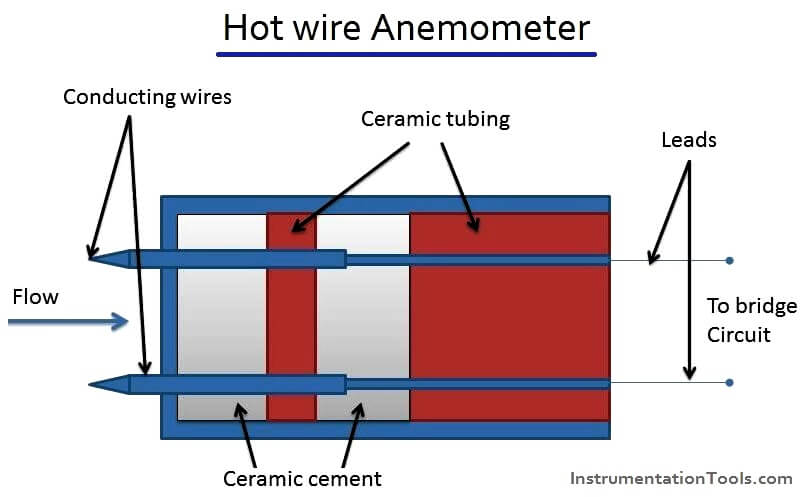Hot Wire Anemometer works When an electrically heated wire is placed in a flowing gas stream, heat is transferred from the wire to the gas and hence the temperature of the wire reduces, and due to this, the resistance of the wire also changes. This change in resistance of the wire becomes a measure of flow rate.

The main parts of the arrangement are as follows:
There are two methods of measuring flow rate using an anemometer bridge combination namely:
The bridge arrangement along with the anemometer has been shown in diagram. The anemometer is kept in the flowing gas stream to measure flow rate.
A constant current is passed through the sensing wire. That is, the voltage across the bridge circuit is kept constant, that is, not varied.
Due to the gas flow, heat transfer takes place from the sensing wire to the flowing gas and hence the temperature of the sensing wire reduces causing a change in the resistance of the sensing wire. (this change in resistance becomes a measure of flow rate).
Due to this, the galvanometer which was initially at zero position deflects and this deflection of the galvanometer becomes a measure of flow rate of the gas when calibrated.
The bridge arrangement along with the anemometer has been shown in diagram. The anemometer is kept in the flowing gas stream to measure flow rate.
A current is initially passed through the wire.
Due to the gas flow, heat transfer takes place from the sensing wire to the flowing gas and this tends to change the temperature and hence the resistance of the wire.
The principle in this method is to maintain the temperature and resistance of the sensing wire at a constant level. Therefore, the current through the sensing wire is increased to bring the sensing wire to have its initial resistance and temperature.
The electrical current required in bringing back the resistance and hence the temperature of the wire to its initial condition becomes a measure of flow rate of the gas when calibrated.
If you liked this article, then please subscribe to our YouTube Channel for Instrumentation, Electrical, PLC, and SCADA video tutorials.
You can also follow us on Facebook and Twitter to receive daily updates.
Read Next:
Design a control system for automatic door lock with delay using PLC programming and motion…
In the PLC emergency stop example program, when the emergency button is pressed, the elevator…
This article is about controlling the double-acting pneumatic cylinder movement control with a timer circuit.
In this article, we will review the main responsibility scopes of the instrumentation and electrical…
Learn the daily alarm PLC program using real-time clock instruction as per the required timings…
A Real-Time Clock accurately tracks time from seconds to years and stores the data in…